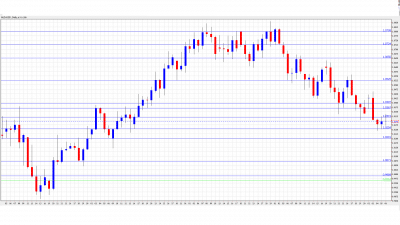AUD/USD was down this week, dropping 130 pips. The pair closed just shy of the 1.03 level, at 1.0296. The upcoming week is very busy, with nine releases. Here is an outlook for the Australian events, and an updated technical analysis for AUD/USD.
The Australian economy continues to churning out weak data, such as Building Approvals and Commodity Prices. Meanwhile, the US is showing improving numbers, such as Initial Jobless Claims, which were close to a four-year low.
Updates: AUD/USD is steady, trading at 1.0290. The Construction Index edged up slightly to 36.2. Job Advertisements fell sharply, posting a 1.0% gain. Business Confidence rebounded from last month, posting a respectable level of 3. AUD/USD is trading at 1.0283. Westpac Consumer Sentiment improved from last month, but still disappointed, dropping by -1.6%. The indicator has now posted two consecutive readings below in negative territory. Home Loans beat the market forecast, but still dropped by 2.5%. This represents a twelve-month low for the indicator. AUD/USD rebounded from its sharp drop. The pair crossed the 1.03 level, and is trading at 1.0314. MI Inflation Expectations jumped 3.3%, up from 2.7% in March. Employment Change sparkled, posting a reading of 44.0. The market forecast called for an increase of only 6.4K. The Unemployment Rate remained steady at 5.3%. The aussie is up sharply, as AUD/USD is trading at the 1.04 line.
AUD/USD graph with support and resistance lines on it. Click to enlarge:
-
Chinese CPI: Monday, 1:30. The Chinese inflation index has important ramifications for Australia, as it China’s number one trading partner. Inflation was as high as 6.1% in October 2011, but has since fallen, posting a rate of 3.2% in March . The April forecast calls for a slight rise in the index, to 3.4%.
-
AIG Construction Index: Monday, 23:30. The index is on a three-month downswing, and over the past 12 months, it has managed to climb above the 40 level just once. This is a clear indication 0f sustained weakness in the construction sector. The index recorded a reading of just 35.6 in March ,and another drop this month would be bearish for the Aussie.
-
ANZ Job Advertisements: Tuesday, 1:30. The indicator tends to be volatile from month to month. Although the indicator was down in March, it still posted a respectable reading of 3.3%.
-
NAB Business Confidence: Tuesday, 1:30. This leading indicator dropped sharply to 1 last month, its worst reading since October 2011. Any reading above 0 indicates improving conditions. Will the indicator rebound and move upwards in April?
-
Chinese Trade Balance: Publication time tentative. Traders should treat these figures with caution, as they are often leaked to the media prior to publication time. The March reading plunged to -31.5B, the first monthly trade deficit since March 2011. Will April bring better news and a trade surplus?
-
Westpac Consumer Sentiment: Wednesday, 00:30. This indicator of consumer confidence tends to be quite volatile. The indicator dropped sharply in March, posting a reading of -5.o%. This was the first reading in negative territory since December 2011. Will the indicator bounce back with a reading above zero this month?
-
Home Loans: Wednesday, 1:30. Home Loans dropped by 1.2% in March, its worst reading since May 2011. The markets are predicting further bad news, with a forecast of -3.7% in April.
-
MI Inflation Expectations: Thursday, 1:00. Inflation has been fairly steady in recent months, ranging between 2-3%. Little change is expected in the April reading.
-
Employment Change: Thursday, 1:30. The March reading was a disappointment, as the indicator posted a drop of -15.4K, well below the market forecast of 5.1K. The markets are predicting a sharp improvement in April, with a forecast of 6.7K. The Unemployment Rate was 5.3% in March, and the forecast is for the indicator to inch downwards, to 5.2%.
* All times are GMT
AUD/USD Technical Analysis
AUD/USD opened at 1.0426. The pair reached a high of 1.0462, and then dropped as low as 1.0243, as it broke through the support level of 1.0250 (discussed last week). AUD/USD then recovered somewhat, closing at 1.0296.
Technical levels from top to bottom:
We start with resistance at the round number of 1.08, which AUD/USD last tested in February. The next line of resistance is at 1.0724, which has strengthened as the US dollar has continued to improve against its Australian counterpart.
This is followed by strong resistance at 1.0650. The pair exhibited quite a bit of movement around the 1.0525 line in March. It is now acting in a resistance role. Below, 1.0402 was breached this week, and is now providing resistance following the downward movment of AUD/USD.
Close by, 1.0372 is providing resistance to the pair. This line has been tested several times in April, and we could see this line continue to come under further attack.
The line of 1.0320 was breached again this week by AUD/USD, and is providing weak resistance to the pair. Below, there is strong support level of 1.0250. However, this line could be tested if the US dollar continues where it left off and makes further inroads against the Australian dollar.
This is followed by support at the round figure of 1.02, This level has provided strong support to AUD/USD since January. Next, is the support level of 1.0080, which is protecting the all-important parity level. Although parity has not been breached since December 2011, further rallying by the US dollar could put this psychologically important level within reach. The final support level for now is at 0.9964, a strong support level dating back to last December.
I am bearish on AUD/USD.
AUD/USD continues to push downwards, as the aussie is no match for the robust US dollar. Weaker global activity, especially in China, Australia’s number one trading partner, is weighing on the Australian dollar. If the US economy produces some strong data, the greenback could continue to shine against the aussie.
Further reading:
- For a broad view of all the week’s major events worldwide, read the USD outlook.
- For EUR/USD, check out the Euro to Dollar forecast.
- For the Japanese yen, read the USD/JPY forecast.
- For GBP/USD (cable), look into the British Pound forecast.
- For the Australian dollar (Aussie), check out the AUD to USD forecast.
- For the New Zealand dollar (kiwi), read the NZD forecast.
- For USD/CAD (loonie), check out the Canadian dollar forecast.

